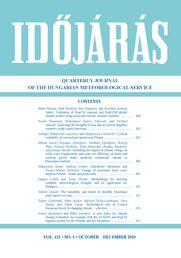Időjárás - Quarterly Journal of the Hungarian Meteorological Service (OMSZ)
Vol. 123, No. 4 * Pages 409–576 * October - December 2019
 |
Special compilation: Environmental challenges – Smart solutions |
 download [pdf: 3546 KB]
download [pdf: 3546 KB]
Validation of RegCM regional and HadGEM global climate models using mean and extreme climatic variables
Ildikó Pieczka, Judit Bartholy, Rita Pongrácz, and Karolina Szabóné André
DOI:10.28974/idojaras.2019.4.1 (p. 409–)
Ildikó Pieczka, Judit Bartholy, Rita Pongrácz, and Karolina Szabóné André
DOI:10.28974/idojaras.2019.4.1 (p. 409–)
Analyzing the droughts in Iran and its eastern neighboring countries using copula functions
Yousef Ramezani, Mohammad Nazeri Tahroudi, and Farshad Ahmadi
DOI:10.28974/idojaras.2019.4.2 (p. 435–)
Yousef Ramezani, Mohammad Nazeri Tahroudi, and Farshad Ahmadi
DOI:10.28974/idojaras.2019.4.2 (p. 435–)
Cyclical variability of seasonal precipitation in Poland
Jadwiga Nidzgorska-Lencewicz and Małgorzata Czarnecka
DOI:10.28974/idojaras.2019.4.3 (p. 455–)
Jadwiga Nidzgorska-Lencewicz and Małgorzata Czarnecka
DOI:10.28974/idojaras.2019.4.3 (p. 455–)
Modeling the impact of climate change on yield, water requirements, and water use efficiency of maize and soybean grown under moderate continental climate in the Pannonian lowland
Milena Jancic Tovjanin, Vladimir Djurdjevic, Borivoj Pejic, Nebojsa Novkovic, Beba Mutavdzic, Monika Markovic, and Ksenija Mackic
DOI:10.28974/idojaras.2019.4.4 (p. 469–)
Milena Jancic Tovjanin, Vladimir Djurdjevic, Borivoj Pejic, Nebojsa Novkovic, Beba Mutavdzic, Monika Markovic, and Ksenija Mackic
DOI:10.28974/idojaras.2019.4.4 (p. 469–)
Change of maximum snow cover depth in Poland – trends and projections
Małgorzata Szwed, Andreas Dobler, Abdelkader Mezghani, and Tuomo Mikael Saloranta
DOI:10.28974/idojaras.2019.4.5 (p. 487–)
Małgorzata Szwed, Andreas Dobler, Abdelkader Mezghani, and Tuomo Mikael Saloranta
DOI:10.28974/idojaras.2019.4.5 (p. 487–)
Methodology for deriving synthetic meteorological droughts and its application for Budapest
Ognjen Gabrić and Jasna Plavšić
DOI:10.28974/idojaras.2019.4.6 (p. 501–)
Ognjen Gabrić and Jasna Plavšić
DOI:10.28974/idojaras.2019.4.6 (p. 501–)
The variability and trends of monthly maximum wind speed over Iran
Sohrab Ghaedi
DOI:10.28974/idojaras.2019.4.7 (p. 521–)
Sohrab Ghaedi
DOI:10.28974/idojaras.2019.4.7 (p. 521–)
Hydrological role of Central European forests in changing climate –review
Zoltán Gribovszki, Péter Kalicz, Michael Palocz-Andresen, Dóra Szalay, and Tünde Varga
DOI:10.28974/idojaras.2019.4.8 (p. 535–)
Zoltán Gribovszki, Péter Kalicz, Michael Palocz-Andresen, Dóra Szalay, and Tünde Varga
DOI:10.28974/idojaras.2019.4.8 (p. 535–)
A new index for climate change evaluation – An example with the ALADIN and RegCM regional models for the Balkans and the Apennines
Valery Spiridonov and Rilka Valcheva
DOI:10.28974/idojaras.2019.4.9 (p. 551–)
Valery Spiridonov and Rilka Valcheva
DOI:10.28974/idojaras.2019.4.9 (p. 551–)
IDŐJÁRÁS - Quarterly Journal

Az IDŐJÁRÁS a HungaroMet Nonprofit Zrt. negyedévenként megjelenő angol nyelvű folyóirata
Megrendelhető a journal.idojaras@met.hu címen.
A szerzőknek szánt útmutató itt olvasható.
Megrendelhető a journal.idojaras@met.hu címen.
A szerzőknek szánt útmutató itt olvasható.









